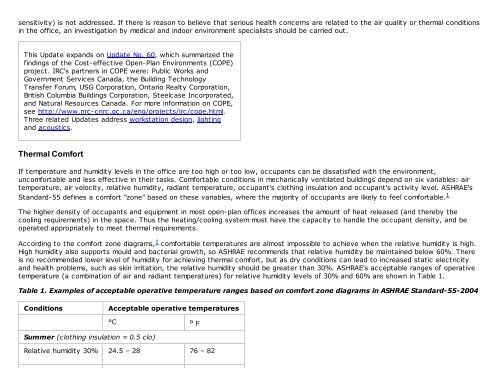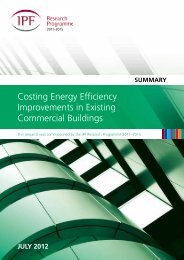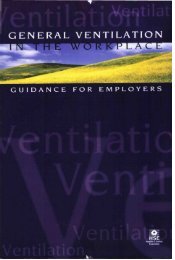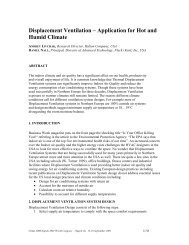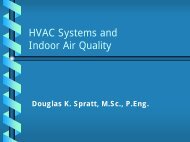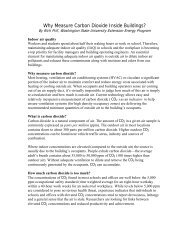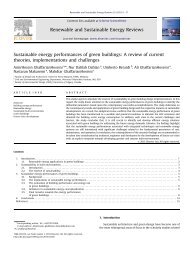sensitivity) is not addressed. If there is reason to believe that serious health concerns are related to the air quality or thermal conditions<strong>in</strong> the office, an <strong>in</strong>vestigation by medical <strong>and</strong> <strong>in</strong>door environment specialists should be carried out.This Update exp<strong>and</strong>s on Update No. 60, which summarized thef<strong>in</strong>d<strong>in</strong>gs of the Cost-effective <strong>Open</strong>-<strong>Plan</strong> Environments (COPE)project. IRC's partners <strong>in</strong> COPE were: Public Works <strong>and</strong>Government Services Canada, the Build<strong>in</strong>g TechnologyTransfer Forum, USG Corporation, Ontario Realty Corporation,British Columbia Build<strong>in</strong>gs Corporation, Steelcase Incorporated,<strong>and</strong> Natural Resources Canada. For more <strong>in</strong>formation on COPE,see http://www.nrc-cnrc.gc.ca/eng/projects/irc/cope.html.Three related Updates address workstation design, light<strong>in</strong>g<strong>and</strong> acoustics.<strong>Thermal</strong> <strong>Comfort</strong>If temperature <strong>and</strong> humidity levels <strong>in</strong> the office are too high or too low, occupants can be dissatisfied with the environment,uncomfortable <strong>and</strong> less effective <strong>in</strong> their tasks. <strong>Comfort</strong>able conditions <strong>in</strong> mechanically ventilated build<strong>in</strong>gs depend on six variables: airtemperature, air velocity, relative humidity, radiant temperature, occupant's cloth<strong>in</strong>g <strong>in</strong>sulation <strong>and</strong> occupant's activity level. ASHRAE'sSt<strong>and</strong>ard-55 def<strong>in</strong>es a comfort "zone" based on these variables, where the majority of occupants are likely to feel comfortable. 1The higher density of occupants <strong>and</strong> equipment <strong>in</strong> most open-plan offices <strong>in</strong>creases the amount of heat released (<strong>and</strong> thereby thecool<strong>in</strong>g requirements) <strong>in</strong> the space. Thus the heat<strong>in</strong>g/cool<strong>in</strong>g system must have the capacity to h<strong>and</strong>le the occupant density, <strong>and</strong> beoperated appropriately to meet thermal requirements.Accord<strong>in</strong>g to the comfort zone diagrams, 1 comfortable temperatures are almost impossible to achieve when the relative humidity is high.High humidity also supports mould <strong>and</strong> bacterial growth, so ASHRAE recommends that relative humidity be ma<strong>in</strong>ta<strong>in</strong>ed below 60%. Thereis no recommended lower level of humidity for achiev<strong>in</strong>g thermal comfort, but as dry conditions can lead to <strong>in</strong>creased static electricity<strong>and</strong> health problems, such as sk<strong>in</strong> irritation, the relative humidity should be greater than 30%. ASHRAE's acceptable ranges of operativetemperature (a comb<strong>in</strong>ation of air <strong>and</strong> radiant temperatures) for relative humidity levels of 30% <strong>and</strong> 60% are shown <strong>in</strong> Table 1.Table 1. Examples of acceptable operative temperature ranges based on comfort zone diagrams <strong>in</strong> ASHRAE St<strong>and</strong>ard-55-2004ConditionsAcceptable operative temperatures°C o FSummer (cloth<strong>in</strong>g <strong>in</strong>sulation = 0.5 clo)Relative humidity 30% 24.5 – 28 76 – 82
Relative humidity 60% 23 – 25.5 74 – 78W<strong>in</strong>ter (cloth<strong>in</strong>g <strong>in</strong>sulation = 1.0 clo)Relative humidity 30% 20.5 – 25.5 69 – 78Relative humidity 60% 20 – 24 68 – 75Occupants vary their cloth<strong>in</strong>g with the seasons, so recommendations for summer <strong>and</strong> w<strong>in</strong>ter are given, to reflect the amount of "cloth<strong>in</strong>g<strong>in</strong>sulation" (clo) that clothes provide. These ranges are valid for typical office activities <strong>and</strong> for air velocities less than 0.2 m/s (40ft./m<strong>in</strong>.). For acceptable operative temperatures for different levels of air velocity, relative humidity, cloth<strong>in</strong>g <strong>in</strong>sulation <strong>and</strong> activity level,refer to ASHRAE's comfort zone diagrams. 1 F<strong>in</strong>d<strong>in</strong>gs from an IRC field study supported what are considered by ASHRAE to be acceptabletemperature ranges. 2Occupants <strong>in</strong> open-plan offices typically have to share one thermostat sett<strong>in</strong>g, reduc<strong>in</strong>g the control they can exert over the thermalenvironment. A flexible dress policy gives occupants one means to f<strong>in</strong>e-tune their thermal comfort, but should not be provided as analternative to appropriate build<strong>in</strong>g temperature control.While occupants can be thermally comfortable overall, they may still experience discomfort on a specific part of their body, mostcommonly from drafts. Their experience of draft depends on air temperature, air velocity, <strong>and</strong> turbulence <strong>in</strong>tensity (the amount offluctuation <strong>in</strong> the air flow). 1 ASHRAE recommends that conditions be configured so that less than 20% of occupants are dissatisfied dueto draft. In general, air temperature with<strong>in</strong> the comfort zone <strong>and</strong> air velocities below 0.2 m/s meet this recommendation, although IRCfound that a velocity of 0.1 m/s or less could lead to a further <strong>in</strong>crease <strong>in</strong> satisfaction. 2ASHRAE allows for higher air velocities <strong>in</strong> warm, humid conditions, as some research suggests that occupants welcome the cool<strong>in</strong>g effectthese higher velocities provide. 3 The proviso is that occupants have control over the local air speed. 1IRC researchers found the alignment of supply air diffusers relative to workstations sometimes led to an <strong>in</strong>creased risk of draft. 2 This ismost likely to be a problem with smaller workstations, where there is less opportunity for occupants to move out of the path of supplyair, <strong>and</strong> where the total airflow is also likely to be higher (to cope with the greater occupant density <strong>and</strong> higher cool<strong>in</strong>g load). As well,there is a greater likelihood of draft when the diffusers are angled to supply large amounts of air directly toward the occupant. When theoffice is reconfigured, it is important to change diffuser placement <strong>and</strong> ventilation volume to help m<strong>in</strong>imize these problems.Occupants seated next to a w<strong>in</strong>dow tend to be less satisfied with thermal conditions. 2 Although workstations located next to w<strong>in</strong>dowsbenefit from natural light<strong>in</strong>g <strong>and</strong> a view, their occupants often experience a wider range of temperatures because of the warm or coolradiant temperatures from the w<strong>in</strong>dow. Bl<strong>in</strong>ds, perimeter heat<strong>in</strong>g <strong>and</strong> cool<strong>in</strong>g, <strong>and</strong> well-<strong>in</strong>sulated w<strong>in</strong>dows can help m<strong>in</strong>imize theseproblems.<strong>Indoor</strong> <strong>Air</strong> <strong>Quality</strong>To achieve good IAQ, many factors must be considered. These <strong>in</strong>clude the type <strong>and</strong> amount of contam<strong>in</strong>ants <strong>in</strong> the space, the quality<strong>and</strong> quantity of the outdoor air supply, the movement of air <strong>and</strong> contam<strong>in</strong>ants with<strong>in</strong> the space, <strong>and</strong> the cleanl<strong>in</strong>ess of the office space<strong>and</strong> ventilation system.


